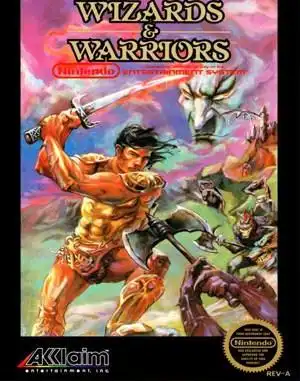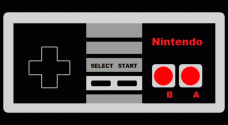The 8-bit era of gaming was a wild frontier, full of ambitious ideas crammed into tiny cartridges. Among the knights, wizards, and platforming heroes, one title stands out with a particular blend of charm and frustration: Wizards & Warriors NES. Developed by the wizards at Rare and published by Acclaim in 1987, this game was a staple for many young adventurers navigating the perilous lands of the Nintendo Entertainment System.
It wasn't just another side-scrolling action game; Wizards & Warriors threw you headfirst into the boots of Kuros, the Knight Warrior, tasked with rescuing the princess from the clutches of the evil wizard Malkil. What followed was a quest defined by treasure hunting, tricky jumps, bizarre enemies, and a surprisingly deep inventory system for the time.
Stepping into the World of Kuros
Released early in the NES's life cycle, Wizards & Warriors immediately grabbed attention with its detailed graphics and memorable soundtrack by David Wise (a Rare legend). You controlled Kuros as he ventured through diverse environments – dark forests, icy caves, fiery dungeons, and eventually, Malkil's imposing Castle IronSpire.
The game's plot was classic fantasy fare: brave knight, evil wizard, captured princess. Simple, yes, but it provided the perfect backdrop for the real meat of the game: exploration and item collection.
More Than Just Jumping: The Unique Gameplay Loop
While it looked like a standard platformer, Wizards & Warriors had its own rhythm. Progress wasn't just about reaching the end of the screen; it was about finding keys, collecting gems, and managing a constantly changing inventory.
- Keys & Doors: Color-coded keys were essential, unlocking not just doors but also treasure chests brimming with goodies. Finding the right key was a mini-puzzle in itself.
- Gems & Guardians: Perhaps the most unique (and sometimes annoying) mechanic was the need to collect gems. These weren't just for score; certain guardians blocking your path required a specific number of gems as a bribe to let you pass. This often meant backtracking or grinding enemies, adding a layer of busywork that felt distinctly 80s.
- Verticality: The game loved sending you upwards. Climbing ropes and ladders was frequent, often leading to hidden areas or necessary items.
The Arsenal of a Knight (and Why Some Bits Were Better)
Kuros wasn't just armed with his default Brightsword. Wizards & Warriors featured a plethora of temporary items found in chests, torches, and even acorns. These items granted crucial abilities:
- Projectile Weapons: The Dagger of Throwing and Battle Axe of Agor were game-changers. Unlike the short-range, awkward sword swing, these boomerang-like weapons allowed you to hit enemies from a distance, making many encounters significantly easier. Many players remember these fondly as the key to survival.
- Movement Aids: The Potion of Levitation allowed for controlled floating, while the Feather of Feather Fall provided a slow, safe descent. These were invaluable for navigating the game's often unforgiving platforming sections.
- Boots of Force: Needed to open chests without keys. Picking these up at the wrong time could be frustrating if they replaced a more useful item.
- Other Trinkets: Temporary invincibility, speed boots, magic spells – the variety was impressive, even if some items felt less impactful than others.
Managing which temporary item you had equipped was a constant strategic decision, often made on the fly after breaking open a container.
That Classic NES Challenge (and How We Cheated It)
Wizards & Warriors NES was tough. Enemies spawned frequently, platforming required precision (sometimes hampered by slightly slippery controls), and falling from heights was a constant threat. Bosses, while often visually interesting, could be brutal tests of pattern recognition and item usage.
However, the game offered a lifeline: unlimited continues. While this reset your score, it allowed you to pick up right where you left off, items intact. This feature, unusual for the time, made the game more accessible to younger players grappling with its difficulty. In the modern era, playing via emulation adds save states and rewind features, which truly transform the experience, allowing players to experiment and overcome frustrating sections without repeating large chunks.
Beyond the First Quest: Sequels and Legacy
Wizards & Warriors was successful enough to spawn several sequels, including Ironsword: Wizards & Warriors II and Wizards & Warriors III: Kuros: Visions of Power. While these games built upon the foundation, they often tweaked mechanics in ways that weren't universally loved (like the removal of the beloved projectile weapons in Ironsword).
Kuros even made appearances in other media, showing up in the Saturday morning cartoon The Power Team (which also featured characters like Bigfoot the monster truck!) and the Captain N: The Game Master cartoon, cementing his place in 80s gaming pop culture. The game was also novelized in the "Worlds of Power" book series aimed at young readers.
Is Wizards & Warriors Worth Playing Today?
For retro gamers, absolutely. Wizards & Warriors NES is a fascinating snapshot of Rare's early work and Acclaim's publishing strategy. It's quirky, sometimes frustrating, but undeniably charming. The graphics still hold a certain 8-bit appeal, and David Wise's music is as catchy as ever.
While some mechanics feel dated (the gem grinding, the sword combat), the item system and vertical level design offer something a bit different from its contemporaries. Playing with modern conveniences like save states can smooth over the rough edges, allowing you to appreciate the exploration and platforming without the constant fear of instant death resetting your progress.
It might not be the most polished NES title, but Wizards & Warriors remains a memorable adventure for those who braved its challenges back in the day or are discovering its unique magic now.
Frequently Asked Questions (FAQ)
Q: Who developed Wizards & Warriors on NES? A: The game was developed by Rare Ltd., who would go on to create many beloved titles for Nintendo platforms.
Q: Was there a sequel to the game? A: Yes, there were three sequels: Ironsword: Wizards & Warriors II, Wizards & Warriors III: Kuros: Visions of Power, and Wizards & Warriors IV: The Fortress of Fear (Game Boy).
Q: Is Wizards & Warriors considered a difficult game? A: Yes, it is known for being quite challenging due to frequent enemy spawns, tricky platforming, and boss fights, though the unlimited continues made it more manageable than some other tough NES games.
Q: Can I play Wizards & Warriors on modern systems? A: Currently, Wizards & Warriors NES has not been officially re-released on modern digital platforms like Nintendo Switch Online. Playing it typically requires original hardware and cartridges or emulation.


